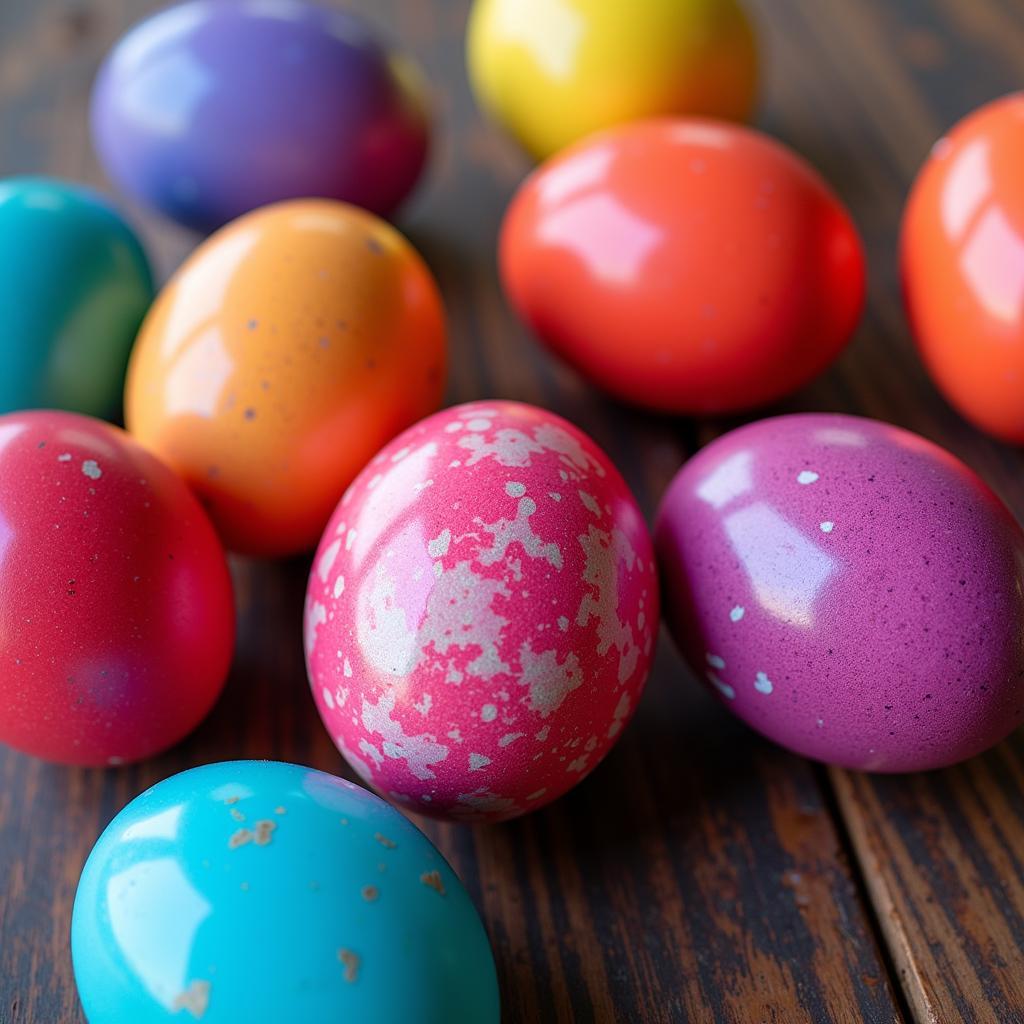Coloring eggs with vinegar is a fun and easy way to add a personal touch to your Easter celebration. But did you know that vinegar plays a crucial role in achieving vibrant and long-lasting colors? It’s true! This simple household ingredient can elevate your egg dyeing game from basic to brilliant.
The Science Behind Vinegar and Egg Dyeing
Vinegar, a mild acid, works its magic by gently etching the surface of the eggshell. This process creates tiny pores that allow the dye to penetrate more deeply, resulting in richer, more vibrant colors.
What You Need for a Vinegar-Powered Egg Dyeing Adventure
Gather your supplies! You’ll need:
- Hard-boiled eggs (still warm for best results)
- White vinegar
- Food coloring (liquid or gel)
- Cups or bowls for dyeing
- Paper towels
- Gloves (optional, but recommended)
- Spoons or tongs for handling eggs
Step-by-Step Guide to Colorful Eggs with Vinegar
- Prepare the Dye Baths: Fill each cup or bowl with about 1 cup of hot water. Add 1 tablespoon of white vinegar to each cup, followed by 20-30 drops of your desired food coloring. Stir well to ensure the dye is evenly distributed.
- Dip and Dye: Gently lower each egg into a dye bath. Use a spoon or tongs to ensure the egg is completely submerged. Leave the eggs in the dye for as little as 5 minutes for pastel shades or up to 30 minutes for deeper, more intense hues.
 Vibrant Vinegar-Dyed Eggs
Vibrant Vinegar-Dyed Eggs - Dry and Admire: Once you’ve achieved your desired color intensity, carefully remove the eggs from the dye baths using a spoon or tongs. Place them on a paper towel-lined surface to dry.
Tips and Tricks for Egg-cellent Results
-
Warm Eggs, Vibrant Colors: Using warm, freshly boiled eggs allows for better dye absorption, leading to brighter colors.
-
Vinegar is Key: Don’t skip the vinegar! It’s the secret ingredient for achieving those eye-catching hues.
-
Experiment with Time: Varying the dyeing time allows you to create a spectrum of shades from delicate pastels to rich, bold colors.
-
Get Creative with Patterns: Wrap rubber bands around the eggs before dyeing to create stripes or use crayons to draw designs that resist the dye, resulting in unique patterns.
Vinegar: Your Secret Weapon for Colorful Creations
As we’ve learned, vinegar is more than just a salad dressing ingredient; it’s a powerful tool for transforming ordinary eggs into vibrant works of art.
Frequently Asked Questions (FAQs)
Can I use apple cider vinegar instead of white vinegar?
While apple cider vinegar can be used, it may impart a slight yellowish tint to the eggs. White vinegar is recommended for the purest color results.
Can I reuse the dye bath?
For optimal results, it’s best to use a fresh dye bath for each batch of eggs.
How long do vinegar-dyed eggs last?
Vinegar-dyed eggs will last as long as regular hard-boiled eggs, which is about one week when stored properly in the refrigerator.
Can I color eggs with food coloring without vinegar?
Yes, can you color eggs with food coloring, but the colors may not be as vibrant or long-lasting. Vinegar helps to intensify the colors and make them more resistant to fading.
Are there other natural ways to color eggs?
Absolutely! You can achieve beautiful, earthy tones using natural dyes like onion skins (how to color eggs with vinegar), turmeric, and beetroot.
Can I dye eggs with gel food colors?
Can you dye eggs with gel food colors? Yes, absolutely! Gel food coloring is highly concentrated, resulting in even more vibrant and intense colors compared to liquid food coloring.
Can I color eggs without boiling them?
Can you color eggs without boiling them? No, you need to hard-boil the eggs first to ensure the dye adheres properly and the colors turn out vibrant.
How do you color eggs with Kool-Aid?
How do you color eggs with kool aid? You can create vibrantly colored Easter eggs by dissolving unsweetened Kool-Aid packets in water and vinegar to create a dye bath.
How to use food coloring to dye eggs?
How to use food coloring to dye eggs? It involves creating a dye bath with food coloring, water, and vinegar, then submerging hard-boiled eggs in the solution to achieve the desired colors.
This Easter, unleash your inner artist and create a kaleidoscope of colorful eggs with the help of vinegar. Happy dyeing!
Need help with your next home decorating project? Contact us at:
Phone Number: 0373298888
Email: [email protected]
Address: 86 Cầu Giấy, Hà Nội
We have a 24/7 customer service team ready to assist you.
